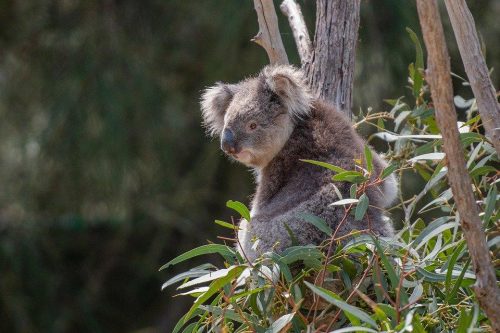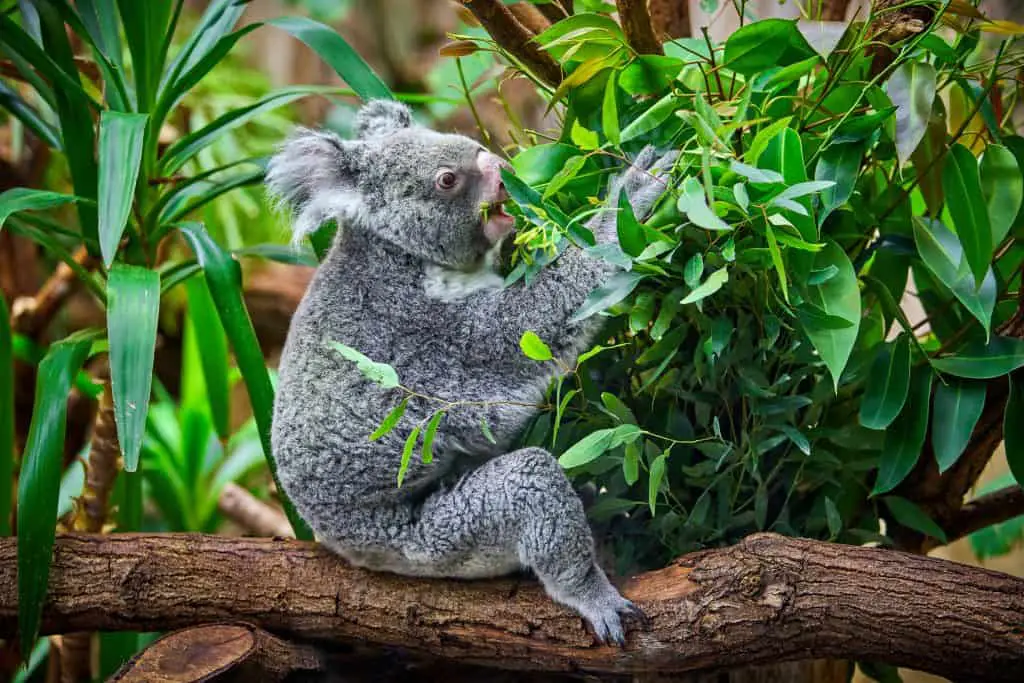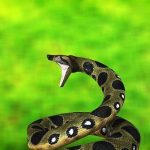Koalas are a unique and fascinating animal that many people find interesting. These marsupials are native to Australia and are known for their fluffy ears, adorable faces, and love of eucalyptus leaves. While they are often called koala bears, they are not actually bears at all. In fact, they are more closely related to kangaroos and wombats.

Despite their cute and cuddly appearance, koalas are actually quite fascinating creatures. For example, did you know that koalas have fingerprints that are almost identical to human fingerprints? This is just one of many interesting facts about koalas that people may not be aware of. In this article, we will explore some of the most fun and surprising facts about these beloved marsupials.
Koala Bear Basics
Species Classification
Koalas are not actually bears, they are marsupials. They belong to the family Phascolarctidae and their scientific name is Phascolarctos cinereus. They are native to Australia and are classified as a vulnerable species due to habitat loss, disease, and climate change.
Physical Characteristics
Koalas have a unique appearance with their fluffy ears, button nose, and round body. They have thick fur that is gray in color and helps them stay cool in hot weather. Their front paws have two opposable digits that help them grip onto branches and climb trees. They have a pouch on their belly where they carry and nurse their young, called joeys.
Habitat
Koalas are found in the eucalyptus forests of eastern and southeastern Australia. They are arboreal and spend most of their time in trees, sleeping for up to 18 hours a day. They have a very specific diet, feeding almost exclusively on the leaves of eucalyptus trees. They are able to obtain all the water they need from the leaves they eat.
Koala Bear Diet
Koalas are herbivorous marsupials that feed exclusively on the leaves of eucalyptus trees. They are known to consume up to 1 kg of eucalyptus leaves per day, which is approximately 200-500 grams of dry matter.
Primary Food Source
Eucalyptus leaves are the primary food source of koalas. These leaves are high in fiber and low in nutrition, making them difficult to digest. However, koalas have a specialized digestive system that allows them to break down the tough eucalyptus leaves and extract the nutrients they need.
Koalas have a long digestive tract, which allows them to break down the tough fibers in eucalyptus leaves. They also have a unique digestive system that contains bacteria that help break down the toxic compounds in eucalyptus leaves.
Hydration
Koalas obtain most of their water from the eucalyptus leaves they eat. Eucalyptus leaves are low in water content, which means that koalas have to conserve water in their bodies.
Koalas have a highly efficient kidney system that allows them to recycle water in their bodies. They can also obtain water from other sources, such as dew on the leaves and rainwater.
In summary, koalas have a specialized diet that consists of eucalyptus leaves. They have a unique digestive system that allows them to break down the tough fibers in eucalyptus leaves and extract the nutrients they need. They also have a highly efficient kidney system that allows them to conserve water in their bodies.
Behavior and Lifestyle
Sleeping Habits
Koalas are known for their sleeping habits. They sleep for up to 18 hours a day, which is believed to be an adaptation to their leaf-based diet, as they get very little energy from just eating leaves. Koalas are arboreal animals, which means they spend most of their time in trees. They sleep during the day and are most active at night. When they do sleep, they usually curl up in the fork of a tree, using their bushy tail as a pillow.
Social Behavior
Koalas are generally solitary animals and do not live in large groups. However, they do have a social hierarchy. Males have a larger home range than females, and dominant males will have access to more females. They communicate with each other using a range of vocalizations, including grunts, bellows, and snores. They also use scent marking to establish their territory and communicate with other koalas. Despite their solitary nature, koalas have been known to form close bonds with other koalas and even other species, such as kangaroos.
Diet
Koalas are herbivores and feed almost exclusively on eucalyptus leaves. They have a specialized digestive system that allows them to break down the tough eucalyptus leaves, which are toxic to most other animals. They have a slow metabolism and derive most of their water from the leaves they eat. Koalas have a unique digestive system that allows them to extract as much nutrition as possible from their food. They have a special bacteria in their stomach that helps break down the eucalyptus leaves.
Overall, koalas are fascinating animals with unique behaviors and adaptations that allow them to survive in their natural habitat.
Reproduction and Lifespan
Mating Season
Koalas have a breeding season that typically lasts from December to March. During this time, male koalas mark their territory with their scent and loud bellows to attract females. Female koalas are known to be quite picky when it comes to choosing a mate. They will only mate with males who have a strong scent and a deep bellow. After mating, the female koala will give birth to a single joey after a gestation period of 35 days.
Life Expectancy
Koalas have a relatively long lifespan for their size, with an average life expectancy of 13-18 years in the wild. In captivity, koalas have been known to live up to 20 years or more. However, their lifespan can be affected by a number of factors, including habitat loss, disease, and accidents. Female koalas can give birth to up to six joeys during their lifetime, but they usually only have one or two offspring due to the long period of time between births.
In conclusion, koalas have a unique reproductive system and relatively long lifespan for their size. Understanding these facts is important for conservation efforts and the preservation of this beloved species.
Threats and Conservation
Predators
Although koalas are not typically preyed upon by other animals, they do have natural predators such as dingoes, goannas, and pythons. These predators pose a significant threat to koalas, particularly young joeys who are more vulnerable.
Environmental Threats
The greatest threat to koalas is habitat loss due to deforestation, urbanization, and bushfires. As a result, koalas are losing their homes and food sources, which has led to a decline in their population. In addition, koalas are susceptible to diseases such as chlamydia and retrovirus, which can spread rapidly due to their close proximity to one another.
Conservation Efforts
Several organizations, such as the Australian Koala Foundation, are working to protect koalas and their habitats. Efforts include planting eucalyptus trees, creating wildlife corridors, and rehabilitating injured or sick koalas. In addition, the government has implemented laws and regulations to protect koalas and their habitats. Despite these efforts, much more needs to be done to ensure the survival of this iconic species.
In conclusion, while koalas are beloved around the world for their cute and cuddly appearance, they face significant threats to their survival. It is important for individuals, organizations, and governments to work together to protect koalas and their habitats for future generations to enjoy.
Koalas and Humans
Koalas in Zoos
Koalas are a popular attraction in zoos around the world. According to National Geographic Kids, koalas sleep for up to 18 hours a day and are often seen dozing off in trees. In zoos, they are often kept in enclosures that mimic their natural habitat, complete with eucalyptus trees for them to climb and rest in. Visitors can observe these marsupials up close and learn about their unique characteristics, such as their opposable thumbs and pouches for carrying their young.
Koalas in Popular Culture
Koalas have become a symbol of Australia and are featured in various forms of popular culture. According to Fact Retriever, koalas have been depicted in children’s books, cartoons, and movies. One of the most famous fictional koalas is Blinky Bill, a character from a series of children’s books by Dorothy Wall. In recent years, koalas have also been used as mascots for various companies and organizations, such as the Australian airline Qantas.
Overall, koalas have captured the hearts of people around the world with their cute and cuddly appearance and unique characteristics. Whether seen in zoos or on TV, these marsupials continue to fascinate and entertain people of all ages.
Interesting Koala Bear Facts
Unique Adaptations
Koalas are known for their unique adaptations that allow them to survive in their natural habitat. One of their most notable adaptations is their diet. Koalas are herbivores that feed almost exclusively on eucalyptus leaves. These leaves are toxic to most animals, but koalas have a special digestive system that allows them to break down the toxins and extract the nutrients they need.
Another unique adaptation of koalas is their paws. Their front paws have two opposable digits that help them climb trees and grip onto branches. Their back paws have a rough texture that helps them grip onto tree trunks and branches while they sleep.
Fun Trivia
Despite their cute and cuddly appearance, koalas are not actually bears. They are marsupials, which means they carry their young in a pouch. Baby koalas, also known as joeys, are born blind, hairless, and only about 2cm long. They spend the first six months of their lives inside their mother’s pouch, feeding on her milk.
Koalas are also known for their unique vocalizations. They communicate with each other through a variety of sounds, including grunts, snores, and bellows. Male koalas also have a distinctive mating call that sounds like a loud snore.
In addition, koalas are known for their sleeping habits. They can sleep up to 20 hours a day, mostly because their diet of eucalyptus leaves is low in energy. When they are awake, they are usually feeding or moving to a new tree to sleep in.
Overall, koalas are fascinating animals with unique adaptations and behaviors that make them a beloved symbol of Australia.
What Makes Koala Bears and Yaks Both Unique and Fascinating Animals?
Koala bears are iconic for their cuddly appearance and love for eucalyptus leaves, while yaks are known for their shaggy coats and high altitude habitats. Both animals have fun facts about yaks, such as their ability to survive in extreme cold and their importance to the local economy in the Himalayan region.
Frequently Asked Questions

What do koalas eat?
Koalas are herbivores and they primarily eat eucalyptus leaves. They can consume up to 1 kilogram of eucalyptus leaves each day, which is necessary for them to obtain the nutrients they need. They have a special digestive system that allows them to break down the poisonous compounds found in eucalyptus leaves.
Where do koalas live?
Koalas are native to Australia and can be found in the eastern and southeastern parts of the country. They live in eucalyptus forests and woodlands, and are most commonly found in the states of Queensland, New South Wales, Victoria, and South Australia.
How much do koalas weigh?
Koalas are small marsupials, and they typically weigh between 4 and 15 kilograms. The weight of a koala can vary depending on its age, gender, and overall health.
What are 5 interesting facts about koalas?
- Koalas are not bears, they are marsupials.
- Koalas have a specialized digestive system that allows them to break down the toxic compounds found in eucalyptus leaves.
- Baby koalas are called joeys, and they spend the first six months of their lives in their mother’s pouch.
- Koalas are known for their distinctive vocalizations, which can range from grunts and snores to bellows and screams.
- Koalas have fingerprints that are almost indistinguishable from human fingerprints.
What is a gross fact about koalas?
Koalas have a unique odor that is often described as musky or pungent. This odor is caused by the oil secreted by the koala’s scent glands, which is used to mark their territory and communicate with other koalas.
How many koalas are left in 2023?
As of 2023, there are an estimated 58,000 koalas left in the wild in Australia. The koala population has been declining due to habitat loss, disease, and climate change. Efforts are being made to protect and conserve koalas and their habitats.










